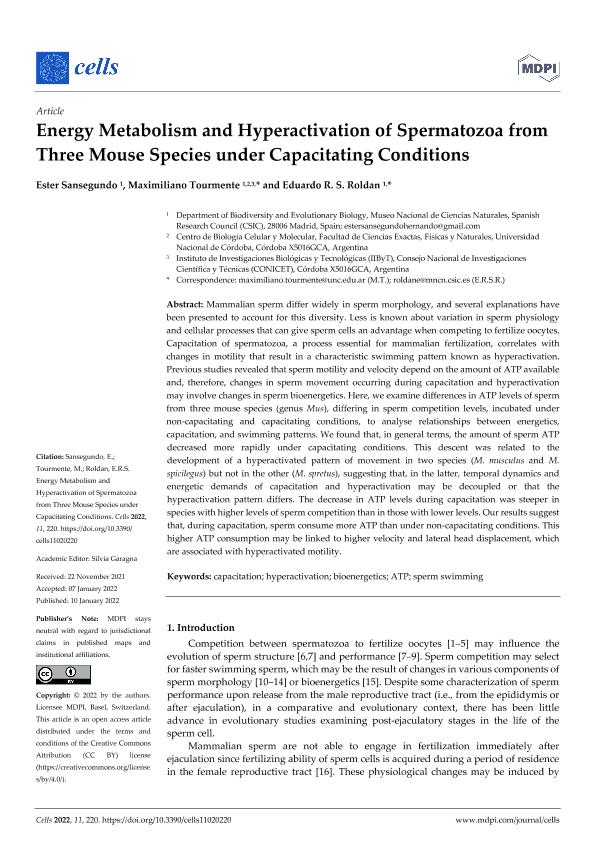Mostrar el registro sencillo del ítem
dc.contributor.author
Sansegundo, Ester
dc.contributor.author
Tourmente, Maximiliano

dc.contributor.author
Roldan, Eduardo
dc.date.available
2022-08-31T15:10:06Z
dc.date.issued
2022-01-10
dc.identifier.citation
Sansegundo, Ester; Tourmente, Maximiliano; Roldan, Eduardo; Energy Metabolism and Hyperactivation of Spermatozoa from Three Mouse Species under Capacitating Conditions; MDPI; Cells; 11; 2; 10-1-2022; 1-26; 220
dc.identifier.uri
http://hdl.handle.net/11336/167037
dc.description.abstract
Mammalian sperm differ widely in sperm morphology, and several explanations have been presented to account for this diversity. Less is known about variation in sperm physiology and cellular processes that can give sperm cells an advantage when competing to fertilize oocytes. Capacitation of spermatozoa, a process essential for mammalian fertilization, correlates with changes in motility that result in a characteristic swimming pattern known as hyperactivation. Previous studies revealed that sperm motility and velocity depend on the amount of ATP available and, therefore, changes in sperm movement occurring during capacitation and hyperactivation may involve changes in sperm bioenergetics. Here, we examine differences in ATP levels of sperm from three mouse species (genus Mus), differing in sperm competition levels, incubated under non-capacitating and capacitating conditions, to analyse relationships between energetics, capacitation, and swimming patterns. We found that, in general terms, the amount of sperm ATP decreased more rapidly under capacitating conditions. This descent was related to the development of a hyperactivated pattern of movement in two species (M. musculus and M. spicilegus) but not in the other (M. spretus), suggesting that, in the latter, temporal dynamics and energetic demands of capacitation and hyperactivation may be decoupled or that the hyperactivation pattern differs. The decrease in ATP levels during capacitation was steeper in species with higher levels of sperm competition than in those with lower levels. Our results suggest that, during capacitation, sperm consume more ATP than under non-capacitating conditions. This higher ATP consumption may be linked to higher velocity and lateral head displacement, which are associated with hyperactivated motility.
dc.format
application/pdf
dc.language.iso
eng
dc.publisher
MDPI
dc.rights
info:eu-repo/semantics/openAccess
dc.rights.uri
https://creativecommons.org/licenses/by/2.5/ar/
dc.subject
CAPACITATION
dc.subject
HYPERACTIVATION
dc.subject
BIOENERGETICS
dc.subject
ATP
dc.subject
SPERM SWIMMING
dc.subject.classification
Biología Reproductiva

dc.subject.classification
Ciencias Biológicas

dc.subject.classification
CIENCIAS NATURALES Y EXACTAS

dc.subject.classification
Bioquímica y Biología Molecular

dc.subject.classification
Ciencias Biológicas

dc.subject.classification
CIENCIAS NATURALES Y EXACTAS

dc.subject.classification
Biología

dc.subject.classification
Ciencias Biológicas

dc.subject.classification
CIENCIAS NATURALES Y EXACTAS

dc.title
Energy Metabolism and Hyperactivation of Spermatozoa from Three Mouse Species under Capacitating Conditions
dc.type
info:eu-repo/semantics/article
dc.type
info:ar-repo/semantics/artículo
dc.type
info:eu-repo/semantics/publishedVersion
dc.date.updated
2022-07-04T19:30:31Z
dc.identifier.eissn
2073-4409
dc.journal.volume
11
dc.journal.number
2
dc.journal.pagination
1-26; 220
dc.journal.pais
Suiza

dc.description.fil
Fil: Sansegundo, Ester. Consejo Superior de Investigaciones Científicas. Museo Nacional de Ciencias Naturales; España
dc.description.fil
Fil: Tourmente, Maximiliano. Consejo Superior de Investigaciones Científicas. Museo Nacional de Ciencias Naturales; España. Consejo Nacional de Investigaciones Científicas y Técnicas. Centro Científico Tecnológico Conicet - Córdoba. Instituto de Investigaciones Biológicas y Tecnológicas. Universidad Nacional de Córdoba. Facultad de Ciencias Exactas, Físicas y Naturales. Instituto de Investigaciones Biológicas y Tecnológicas; Argentina. Universidad Nacional de Córdoba. Facultad de Ciencias Exactas, Físicas y Naturales. Centro de Biología Celular y Molecular; Argentina
dc.description.fil
Fil: Roldan, Eduardo. Consejo Superior de Investigaciones Científicas. Museo Nacional de Ciencias Naturales; España
dc.journal.title
Cells
dc.relation.alternativeid
info:eu-repo/semantics/altIdentifier/url/https://www.mdpi.com/2073-4409/11/2/220
dc.relation.alternativeid
info:eu-repo/semantics/altIdentifier/doi/http://dx.doi.org/10.3390/cells11020220
Archivos asociados
